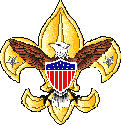| MERIT BADGES |
|
|
|
|
| Note: Eagle Required are in Italics |
"A"
American
Business
American Culture
American Heritage
American Labor
Animal Science
Archaeology
Archery
Architecture
Art
Astronomy
Athletics
Atomic Energy
Auto Mechanics
Aviation
"B"
Backpacking
Basketry
Bird Study
Bugling
"C"
Camping
Canoeing
Chemistry
Cinematography
Citizenship
Community*
Citizenship Nation*
Citizenship World*
Climbing
Coin Collecting
Collections
Communications*
Computers
Cooking
Crime Prevention
Cycling*
"D"
Dentistry
Disability Awareness
Dog Care
Drafting
"E"
Electricity
Electronics
Emergency
Preparedness**
Energy
Engineering
Entrepreneurship
Environmental
Science*
"F"
Family Life*
Farm Mechanics
Fingerprinting
Fire Safety
First Aid*
Fish & Wildlife Mgmt.
Fishing
Fly Fishing
Forestry
"G"
Gardening
Genealogy
Geology
Golf
Graphic Arts
"H"
Hiking
Home Repairs
Horsemanship
"I"
Indian Lore
Insect Studies
"J"
Journalism
"K"
"L"
Landscape Architecture
Law
Leatherwork
Lifesaving**
"M"
Mammal Study
Medicine
Metalwork
Model Design & Building
Motorboating
Music
"N"
Nature
"O"
Oceanography
Orienteering
"P"
Painting
Personal Fitness**
Personal Management*
Pets
Photography
Pioneering
Plant Science
Plumbing
Pottery
Public Health
Public Speaking
Pulp and Paper
"Q"
"R"
Radio
Railroading
Reading
Reptile & Amphibian Study
Rifle Shooting
Rowing
"S"
Safety
Salesmanship
Scholarship
Sculpture
Shotgun Shooting
Skating
Skiing
Small Boat Sailing
Soil & Water
Conservation
Space Exploration
Sports**
Stamp Collecting
Surveying
Swimming**
"T"
Textile
Theatre
Traffic Safety
Truck Transportation
"U"
"V"
Veterinary Medicine
"W"
Water Skiing
Weather
Whitewater
Wilderness Survival
Wood Carving
Woodwork
"X"
"Y"
"Z"
 Bird
Study Bird
StudyRequirements 1999 |
- Explain the need for bird study and why birds are useful indicators of the quality of the environment.
- Show that you are familiar with the terms used to describe birds by sketching or tracing a perched bird and then labeling 15 different parts of the bird. Sketch or trace an extended wing and label types of wing feathers.
- Demonstrate that you know how to properly use and care for binoculars.
- Explain what the specification numbers on the binoculars mean.
- Show how to adjust the eyepiece and how to focus for proper viewing.
- Show how to properly care for and clean the lenses.
- Demonstrate that you know how to use a bird field guide. Show your counselor that you
are able to understand a range map by locating in the book and pointing out the wintering
range, the breeding range, and/or the year-round range of one species of each of the
following types of birds:
- Petrel
- Plover
- Falcon
- Warbler or vireo
- Heron or egret
- Sparrow
- Nonnative bird (introduced to North America from a foreign country since 1800)
- Observe and be able to identify at least 20 species of wild birds. Prepare a field
notebook, making a separate entry for each species, and record the following information
from your field observations and other references.
- Note the date and time.
- Note the location and habitat.
- Describe the bird's main feeding habitat and list two types of food that the bird is likely to eat.
- Note whether the bird is a migrant or a summer, winter, or year-round resident of your area.
- Be able to identify five of the 20 species in your field notebook by song or call alone. For each of these five species enter a description of the song or call, and note the behavior of the bird making the sound. Note why you think the bird was making the call or song that you heard.
- Do ONE of the following:
- Go on a field trip with a local club or with others who are knowledgeable about birds in
your area.
- Keep a list or fill out a checklist of all the birds your group observed during the field trip.
- Tell your counselor which birds your group saw and why some species were common and some were present in small numbers.
- Tell your counselor what makes the area you visited good for finding birds.
- By using a public library or contacting the National Audubon Society, find the name and
location of the Christmas Bird Count nearest your home and obtain the results of a recent
count.
- Explain what kinds of information are collected during the annual event.
- Tell your counselor which species are most common, and explain why these birds are abundant.
- Tell your counselor which species are uncommon, and explain why these were present in small numbers. If the number of birds of these species is decreasing, explain why, and what, if anything, could be done to reverse their decline.
- Go on a field trip with a local club or with others who are knowledgeable about birds in
your area.
- Do ONE of the following. For the option you choose, describe what birds you hope to
attract, and why.
- Build a bird feeder and put it in an appropriate place in your yard or another location.
- Build a birdbath and put it in an appropriate place.
- Build a backyard sanctuary for birds by planting trees and shrubs for food and cover.
|
||||||
Last Update May 15, 2023

.jpg)
